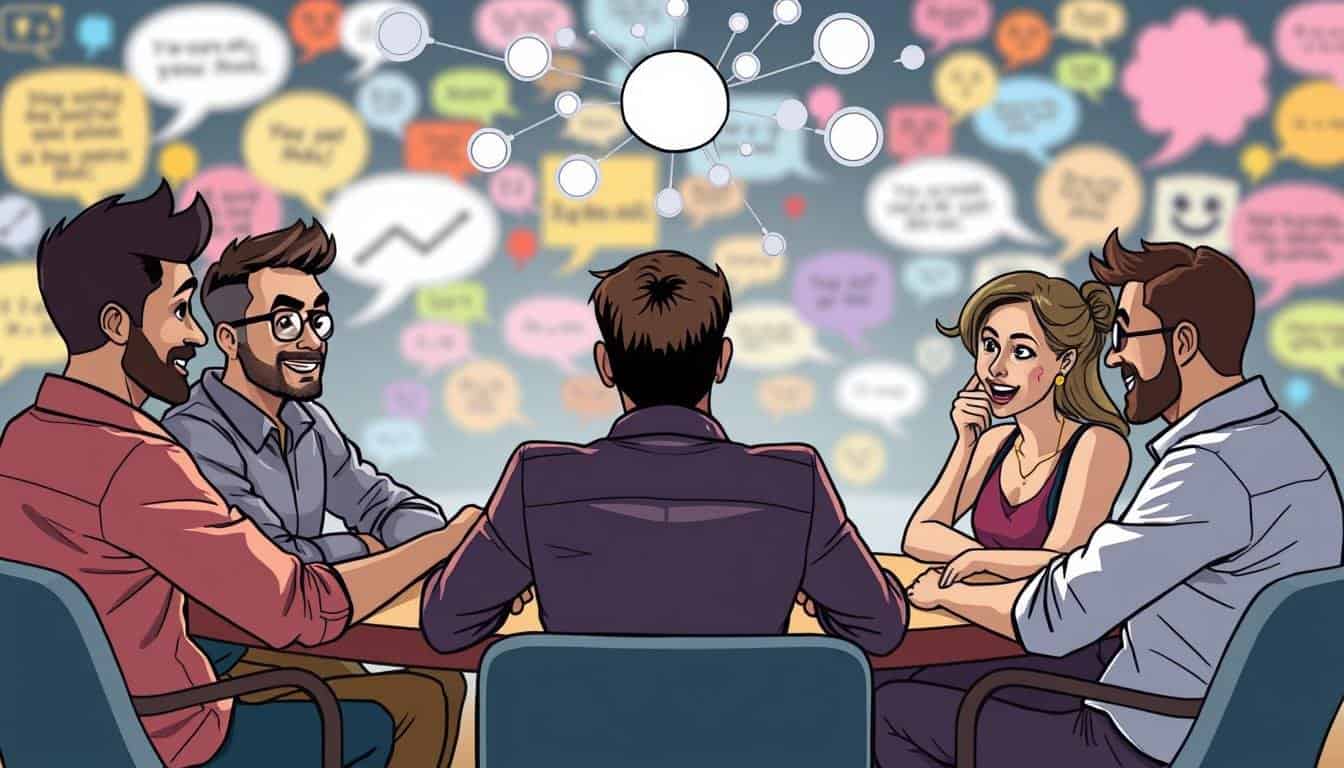Understanding Groupthink in Decision-Making
Have you ever seen a team make a bad decision, even with lots of information? This is called groupthink. It’s when teams choose to agree over thinking things through. Irving Janis first talked about it in 1972. He showed how groups can ignore other ideas, stop different opinions, and make bad choices.
This article will look at groupthink. We’ll talk about its history, why it happens, and how it affects today’s teams.
Key Takeaways
- Groupthink makes teams choose agreement over careful thinking.
- Being close as a group can make members hide their true thoughts.
- Decisions from groupthink often miss out on exploring other options.
- Being part of a group affects how likely someone is to speak up with different views.
- Examples of groupthink include the Bay of Pigs and the Challenger disaster.
- Knowing about groupthink helps make better decisions in many areas.
What is Groupthink?
Groupthink is a psychological phenomenon that affects many areas like communication studies, political science, and organizational theory. It happens when group members focus too much on agreeing together. This can lead to ignoring other ideas and making bad decisions.
Definition and Origin
The term “groupthink” was first used in 1952 by William H. Whyte Jr. Irving Janis made it more popular in 1972. He showed how wanting to get along can stop people from thinking for themselves. Groupthink means making decisions without considering all sides, which can lead to bad results.
Irving Janis and the Concept
Irving Janis did a lot of research on groupthink. He looked at events like the Bay of Pigs and Pearl Harbor. Janis found that groupthink can cause people to overestimate their group’s abilities and morality. This can lead to poor political decisions.
Examples of Groupthink in History
Groupthink has caused problems throughout history. The Challenger shuttle disaster, Watergate, and the Vietnam War are examples. These events show how focusing too much on agreement can lead to bad decisions.
The Process of Decision-Making
Understanding how groups make decisions is key to working well together. This process helps groups look at options and reach a common agreement. Everyone’s input is important, but some things affect how decisions are made.
Understanding the Decision-Making Framework
A decision-making framework is like a map that guides groups. It helps them go from identifying problems to picking the best solution. This method makes sure everyone gets involved and can lead to creative ideas.
Working together can lead to better results than competing against each other. This is because groups can share their knowledge and skills.
Role of Groups in Decision-Making
Groups are essential for making good decisions. When members talk and share information, they gather more data. This teamwork helps everyone remember important details, making decisions more informed.
By combining their ideas, group members can come up with new and innovative solutions. This helps avoid missing out on important points that one person might overlook.
Factors Influencing Group Decisions
Many things can affect how groups decide on things. The group’s identity and how close they feel can change how they work together. Strong leadership or high-pressure situations might lead to groupthink, where everyone agrees without fully thinking it over.
Also, groups might stick to what they already know, missing out on crucial information. This can make decisions less objective.
Symptoms of Groupthink
It’s crucial for teams to know the signs of groupthink to make good decisions. Irving Janis pointed out some key traits that can harm a group’s thinking. Knowing these symptoms of groupthink helps teams avoid bad choices and encourages open discussion.
Key Characteristics Identified by Janis
Janis saw groupthink as a situation where everyone in a tight group agrees too much, ignoring different views. The main signs are:
- Illusion of invulnerability
- Collective rationalization
- Belief in inherent morality
- Stereotyped views of out-groups
- Direct pressure on dissenters
- Self-censorship
- Illusion of unanimity
- Mind guards that protect the group from adverse information
Recognizing Illusions of Unanimity
The illusions of unanimity can be very misleading. When everyone thinks they all agree, people are less likely to speak up with doubts. This lack of different views can lead to poor decisions and big problems.
Consequences of Unchecked Beliefs
Groupthink can lead to big problems. It can cause missed chances and even disasters. Decisions made under its influence often don’t work out well. This shows why it’s important to be aware and take steps to prevent it.
| Symptom | Description |
|---|---|
| Illusion of Invulnerability | Group members feel excessively confident about their decisions. |
| Collective Rationalization | Members dismiss warnings and negative feedback. |
| Belief in Inherent Morality | Group members believe their decisions are morally superior. |
| Stereotyped Views of Out-Groups | Negative views about external alternatives are reinforced. |
| Direct Pressure on Dissenters | Dissenting voices face pressure to conform. |
| Self-Censorship | Members suppress their own doubts or concerns. |
| Illusion of Unanimity | Consensus is mistakenly perceived as total agreement. |
| Mind Guards | Individuals shield the group from contrary information. |
Causes of Groupthink
Understanding groupthink is key to preventing bad decisions. It happens in groups that are very close, where wanting to get along can lead to ignoring personal thoughts. This closeness can make personal bonds that stop critical thinking.
High Group Cohesion
Being very close in a group can mean less disagreement. Members feel pushed to agree with everyone else, making it hard for different views to be heard. This can lead to making decisions without looking at all the options.
Leadership Influence on Group Dynamics
The way a leader acts really shapes the group. A leader’s style can keep different opinions from being heard, making it seem like everyone agrees. This stops open talks, leaving out various views and missing important points in decisions.
External Pressures and Threats
Groups often face stress from outside, like tight deadlines or big problems. This stress can make groupthink worse as people might make quick decisions without thinking about everything. This can lead to poor decisions and missing important details.
Impact of Groupthink on Decision-Making
Groupthink changes how groups make decisions. When people focus on agreeing rather than thinking deeply, it leads to bad outcomes. These effects can hurt both short-term and long-term goals.
Consequences for Organizations and Groups
Groupthink creates an environment where important info gets ignored. This can cause problems for organizations, such as:
- Lack of different views leads to poor decisions.
- Risk assessments are often ignored, making things more vulnerable.
- Creativity and new ideas suffer as everyone sticks to the same idea.
Limitations of Critical Thinking
In a groupthink setting, critical thinking has its limits. Teams might:
- Forget to consider other strategies when making decisions.
- Focus too much on what most people think, which can stop new ideas.
- Not see how different views are key to good decisions.
Negative Outcomes in Important Decisions
Groupthink often leads to bad results in big decisions. This is shown by:
- Decisions made with groupthink can lead to huge failures, like the attack on Pearl Harbor.
- Being too sure because everyone agrees can mean missing risks.
- Decisions pushed by group pressure can cost a lot, both money and ethics.
| Impact of Groupthink | Consequences |
|---|---|
| Lack of Diverse Perspectives | Suboptimal Decision-Making |
| Overlooked Alternatives | Missed Opportunities |
| Conformity Pressure | Stifled Innovation |
| Ignorance of Risks | Increased Vulnerability |
| Overconfidence | Financial and Ethical Costs |
Groupthink and Social Psychology
Groupthink is more than just poor decision-making. It’s deeply tied to social psychology, especially in how we follow others and see ourselves as part of a group. People often give up their own ideas to fit in, which can lead to a lack of critical thinking.
This behavior creates an environment where deep discussions are rare. Instead, everyone wants to be together. Understanding how we see ourselves in groups helps us see why groupthink happens.
Conformity and Group Dynamics
Conformity is key in how groups work. Studies, like the Asch Conformity Experiment, show how people can hide their true opinions when others agree. This leads to a situation where agreeing becomes more important than thinking deeply.
When group members focus on being the same rather than being true to themselves, making decisions becomes harder. It stops a full look at all the options.
The Role of Social Identity in Group Decisions
Social identity greatly affects how groups make decisions. People often feel a strong connection to their group, which makes them want to agree with the majority. This can lead to people not speaking up, missing out on different viewpoints.
This effect is seen in big failures like the Enron scandal and historical events like the Bay of Pigs. The drive to fit in can block critical thinking.
Strategies to Prevent Groupthink
To make better decisions and build a healthier work culture, it’s key to stop groupthink. Encouraging different opinions and bringing in diverse views helps a lot. It makes decisions stronger and creates a place where everyone feels safe to share their thoughts.
Encouraging Dissenting Opinions
It’s vital to welcome different opinions to avoid groupthink. Companies like Marco value healthy debate in their culture. They set the stage for respectful challenges among team members. This openness lets everyone share their views, making discussions richer and decisions more complete.
Assigning a Devil’s Advocate
Having a devil’s advocate in meetings is another smart move. This role pushes people to question the main ideas or the group’s agreement. It helps team members look at things from different sides and ensures critical thinking is part of the decision-making.
Breaking Into Smaller Groups for Discussion
Using smaller groups for talks can lessen the need to go along and fight groupthink. These groups offer a chance for deeper conversations. People can share their thoughts more openly and without fear. This leads to a better look at topics and boosts creativity. These methods help improve the work environment by making room for diverse ideas.
Groupthink in a Professional Environment
Groupthink in work settings greatly affects how decisions are made. Studies show that important views were ignored because of group pressure. This highlights the need for diverse opinions to improve decision-making.
Case Studies: The Challenger Disaster
The Challenger disaster is a stark example of what happens with groupthink. Engineers had doubts about the O-rings in cold weather. Yet, NASA valued agreement over individual thoughts. This led to a disaster, showing the value of open debate and different opinions.
The Bay of Pigs and Political Decisions
The Bay of Pigs invasion is another clear example. Leaders were pushed to agree with the group’s views. This led to a poor plan evaluation. It shows how group pressure can lead to bad decisions and outcomes.
Benefits and Drawbacks of Groupthink
Groupthink is a complex issue in decision-making. It has both good and bad sides. While it can make groups work more efficiently, its downsides are often more significant, especially in important situations.
When Groupthink Can Be Helpful
In situations where the stakes are low, groupthink can be beneficial. It helps groups make decisions quickly. This can make everyone feel more united and less anxious.
Being part of a cohesive group can make members feel safe to share their thoughts. However, this can also lead to overconfidence. Groups might ignore other viewpoints, thinking they have the best solution.
Risks and Dangers Associated with Groupthink
Groupthink can be risky for groups. It can stifle creativity, making it hard to think outside the box. Members might not speak up and rationalize their decisions, ignoring important facts.
This can lead to poor decision-making and a lack of innovation. The Abilene Paradox shows how groupthink can cause individuals to agree with decisions they don’t support privately. This can harm productivity and strategic planning.
| Aspect | Benefits | Drawbacks |
|---|---|---|
| Decision-Making Speed | Quick consensus formation | Hasty conclusions without critical review |
| Cohesion | Reduced anxiety among members | Uniformity that stifles diverse viewpoints |
| Group Confidence | Increased confidence in decisions | Overconfidence leading to poor judgments |
| Innovation | – | Lack of creativity and alternative solutions |
| Risk Assessment | – | Ineffectiveness in addressing risks and concerns |
Real-World Examples of Groupthink
Looking at real-world groupthink helps us understand its impact. We see how it affects politics and businesses. By studying these examples, we can avoid its negative effects.
Historical Lessons from Political Decisions
The 1986 Challenger disaster is a sad example of groupthink. Engineers went ahead with the launch despite knowing it was risky. This led to the loss of seven lives.
The Bay of Pigs invasion in 1961 is another cautionary tale. The Kennedy administration launched an attack on Cuba with bad information. This mistake cost 2,403 Americans their lives.
The Pearl Harbor bombing in 1941 is also a lesson in ignoring warnings. Officials thought Japan wouldn’t attack, but they were wrong. This mistake caused a lot of harm.
The Vietnam War shows how groupthink can lead to big mistakes. Officials thought they were right and ignored other views. This led to a long and costly war.
Contemporary Applications in Business
Groupthink isn’t just old news; today’s businesses face it too. For example, marketing teams might push for ideas that aren’t fully thought out. This shows why it’s important to value different opinions at work.
When we look at groupthink in business, we see signs like feeling too sure of ourselves and not speaking up. Studies show that big groups can be more likely to fall into these traps. This highlights the need to understand how groups work.
Understanding the Decision-Making Process in Groups
Groups make decisions better when they understand how they work together. Knowing how decisions are made helps teams work better. By looking at how members interact, teams can spot issues like groupthink early.
This helps make decisions more informed and productive.
Importance of Critical Assessment
Checking how groups work is key to avoiding groupthink. Groups with strong leaders and tight social bonds often make decisions just to fit in. By looking at how they make decisions and spotting biases, teams can handle complex situations better.
This helps members speak up and share their views freely.
Team Collaboration as a Solution
Working together as a team lets everyone share their ideas. Using a devil’s advocate or outside views improves decision-making. Teams that work together come up with new ideas and more solutions.
This teamwork helps spot and fix mistakes, leading to better decisions.
Conclusion
Groupthink is a big threat to good decision-making in groups like companies, governments, and social circles. It comes from wanting everyone to get along and often leads to bad results. For example, the Pearl Harbor attack and the Challenger Space Shuttle disaster show how important it is to question decisions.
To avoid groupthink, it’s key to make sure everyone shares different views. This helps groups work better together and makes their decisions better. By listening to opposing views and using a devil’s advocate, groups can avoid the dangers of groupthink.
Getting past groupthink means valuing different ideas and critical thinking. This makes groups work better and improves decision-making. It leads to new ideas and healthier work environments.







